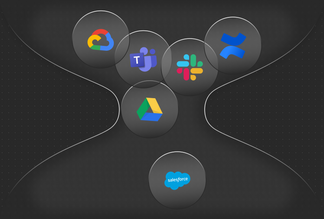

What is a documentation culture? (And how to create one)
As organizations grow, communication is often one of the first things to fail. Knowledge gets increasingly fragmented. More and more time is spent searching for answers to the same questions. In fact, knowledge workers waste almost one hour every day digging through their storage for the info they need, according to our research with Cornell University.
This results in less time being spent on creative, rewarding, and productive work.
An effective knowledge management strategy is critical to addressing those problems. And the first step is creating a documentation culture that’s embedded throughout your organization.
But what does that really mean? And how can you make it a reality?
What we mean by documentation
Documentation is a critical part of knowledge management, but the term simply refers to a way of storing knowledge.
It’s material we use to record, describe, explain, or instruct. Its focus could be a policy or procedure, a system, or an object. And it could take the form of digital material, paperwork, or even audio recordings.
But documentation can’t exist or be useful without people. It needs people who understand and value it. Teams who will create, disseminate, use, and update it.
That’s why a documentation culture is so important. It’s what turns documentation from an administrative overhead into a living, breathing part of the organization. And it’s what creates and sustains its value to individuals and the whole workforce.
Why documentation matters
Knowing how to find key knowledge is important in any organization. But if your business is growing fast, and/or your team is remote or distributed, it’s even more vital.
For example, relying on help from a colleague at a critical moment (via Slack or Teams) isn’t without consequences: it interrupts the person you’re asking, it slows everyone down, and it doesn’t solve the problem for the next person who needs an answer to the same question.
And without a full picture of what’s being worked on throughout the organization, it’s all too easy for work to be duplicated and collaboration opportunities to be missed.
In fact, our research with Cornell University shows that’s exactly what’s happening:
- 61% of professionals in distributed teams say it can be hard to figure out what their colleagues are working on.
- 44% say siloed digital tools make it hard to spot if work is being duplicated.
- 62% report missing opportunities to collaborate and achieve better results.
Addressing those issues in dispersed and flexible teams can bring huge rewards. Another study we worked on with GitLab found that 81% of knowledge workers believe they are more productive and create higher quality output when they have more flexibility over when they work.
Related reading: What is knowledge management and why does it matter?
And for companies that want to attract and retain the brightest and the best, facilitating flexible working is non-negotiable. The same study found that 66% of knowledge workers would resign from a job if their flexibility to choose their hours was limited.
How a documentation culture adds value
An effective documentation culture is about more than simply creating lots of documents. It means everyone is clear about how documents are created, where they’re stored, and how they’re accessed and updated. And it gives everyone ownership of those processes.
The result is both simple and transformative: people are able to find the information they need, when they need it.
For remote or distributed teams, or rapidly growing businesses, that brings a multitude of benefits:
- It helps organizations scale faster, avoiding bottlenecks where essential knowledge is confined to a few key individuals.
- It supports better decision making by democratizing access to up-to-date, accurate information.
- It avoids mistakes by providing authoritative, quality-assured guidance.
- It brings new joiners up to speed faster, empowering them to find answers to questions as they arise.
- It facilitates flexible working by providing information whenever and wherever it’s needed.
How to create a documentation culture
Creating a whole new culture can seem like a daunting task. But put in place these key building blocks, and you’ll create the momentum for real change.
1. Lead from the front
Communicate clear, consistent messages from the very top of the organization. Explain why documentation is important, and be clear that it’s a shared endeavor. Create and capitalize on opportunities to reinforce that message. This will help you build the culture.
2. Share ownership
Give individuals direct responsibility for documenting information in relevant business areas. Be clear about what you expect, and empower them to share new ideas.
3. Set clear guidelines — and hold people to account
Be clear about what’s expected. That means being explicit about how, where, and when you want information to be documented. Check what people are doing. Reward them when things are going well. And if they’re not, let them know what needs to change and why.
4. Be pragmatic
A fully-internalized documentation culture doesn’t happen overnight. So start with the most important aspects of your work to get the ball rolling. For example, FAQs for key cross-organizational processes — like onboarding or ordering equipment. Build up from there, stay consistent, and take the long-term view instead of rushing big changes through.
5. Make it easy with the right tools
Invest in the right documentation tools to make your processes simple. Documentation software that’s easy for users to get to grips with is more likely to be used, and more likely to help foster a sustainable documentation culture in your company.
With Qatalog, the documentation process is effortless because it’s where work is coordinated, decisions are made, and processes are created. That means there’s no need to create separate records. And because it works seamlessly with your other tools, you can find documents wherever they’re stored.
Book a call with our Customer Team to learn more about how Qatalog could help you implement a documentation culture in your organization.



